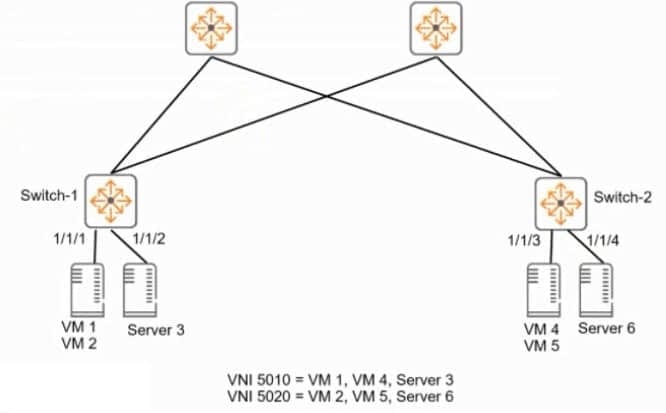Exam Details
Exam Code
:HPE2-W09Exam Name
:Aruba Data Center Network SpecialistCertification
:HP CertificationsVendor
:HPTotal Questions
:129 Q&AsLast Updated
:Mar 29, 2025
HP HP Certifications HPE2-W09 Questions & Answers
-
Question 111:
Is this a guideline for establishing a Virtual Switching Extension (VSX) Inter-Switch Link (ISL) between two ArubaOS-CX switches?
Solution: Use the same speed on every link In the ISL.
A. Yes
B. No
-
Question 112:
Is this a difference between a typical data center network's requirements and a typical campus network's requirements?
Solution: Data center networks are typically less oversubscribed than campus networks.
A. Yes
B. No
-
Question 113:
Is this part of a valid strategy for load sharing traffic across the links in an Ethernet Ring Protection Switching (ERPS) ring?
Solution: Combine multiple links between two data centers into link aggregations (but not multi-chassis ones).
A. Yes
B. No
-
Question 114:
Your customer is using Nutanix AHV and they need a network orchestration tool to simplify network provisioning. Is this operation supported when Aruba Fabric Composer (AFC) is integrated with Nutanix?
Solution: Automated provisioning of LAGs Between AHV and VSX
A. Yes
B. No
-
Question 115:
A customer's servers use ISCSI, and they send data and storage traffic on the same pair of I OGbE links. Is this a best practice for supporting the ISCSI requirements?
Solution: Use Virtual Routing and Forwarding (VRF) to tunnel iSCSI traffic through the network spine on the same links that data traffic uses.
A. Yes
B. No
-
Question 116:
Refer to the exhibit.

: The company wants AtubaOS-CX switches to provide VXLAN services for several VMs and servers, as shown in the exhibit. Hypervisors will not run VXLAN for this solution. Is this part of a valid configuration to meet the requirements? Solution: Work with the server admins to assign a consistent VLAN for VMs 1 and 4. Assign interface 1/1/2 on Switch-1 to the same VLAN.
A. Yes
B. No
-
Question 117:
Refer to the exhibit.

: The company wants AtubaOS-CX switches to provide VXLAN services for several VMs and servers, as shown in the exhibit. Hypervisors will not run VXLAN for this solution. Is this part of a valid configuration to meet the requirements? Solution: Attach VNIs 5010 and 5020 to interface 1/1/3 on Switch-2.
A. Yes
B. No
-
Question 118:
You ate using NetEdit to manage AruDaOS-CX switches. You want to deploy a standard conflg to the switches, but need the config to include a few device-specific settings such as hostname and IP address.
Is this what you should do?
Solution: Instead of using a standard configuration plan to deploy the configuration, create an auto config plan that uses scripts.
A. Yes
B. No
-
Question 119:
You want to use NetEdit to configure an AtubaOS-CX switch.
Is this a minimum requirement for setting up communications between the switch and NetEdit?
Solution: Enable the REST interface in read-only mode.
A. Yes
B. No
-
Question 120:
Is this a guideline for establishing a Virtual Switching Extension (VSX) Inter-Switch Link (ISL) between two ArubaOS-CX switches? Solution: Reserve the ISL for control plane traffic only.
A. Yes
B. No
Related Exams:
HP0-D15
Administering HP CloudSystem Matrix SolutionsHP0-D20
Architecting the HP Matrix Operating EnvironmentHP2-E56
Selling HP SMB SolutionsHP2-H88
Selling HP Business Personal Systems Hardware 2019HP2-I14
Selling HP Supplies 2020HP2-I15
Selling HP Business Personal Systems Hardware 2020HP2-I17
Selling HP Printing Hardware 2020HP2-I44
Selling HP Workstations 2022HP2-I73
Selling HP Retail and Hospitality Solutions 2024HP2-N51
HP Application Lifecycle Management 12.x Software
Tips on How to Prepare for the Exams
Nowadays, the certification exams become more and more important and required by more and more enterprises when applying for a job. But how to prepare for the exam effectively? How to prepare for the exam in a short time with less efforts? How to get a ideal result and how to find the most reliable resources? Here on Vcedump.com, you will find all the answers. Vcedump.com provide not only HP exam questions, answers and explanations but also complete assistance on your exam preparation and certification application. If you are confused on your HPE2-W09 exam preparations and HP certification application, do not hesitate to visit our Vcedump.com to find your solutions here.